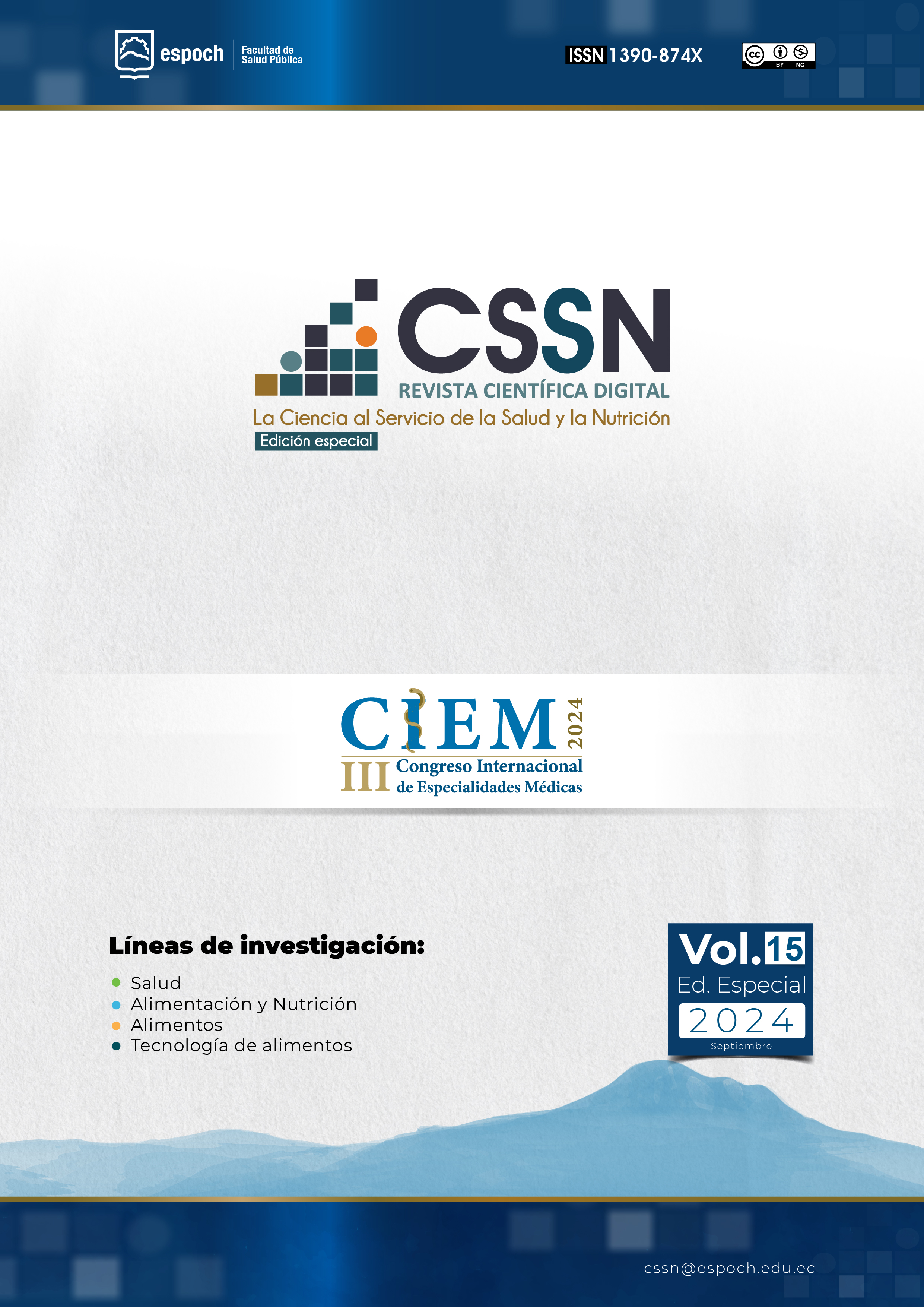Virtual reconstruction as a prototype recreation technique in crime scene evaluations: A bibliographic review
DOI:
https://doi.org/10.47187/cssn.Vol15.IssEd.Esp.313Keywords:
Crime, virtual reality, forensic imaging, forensic medicineAbstract
Introduction: Virtual reconstruction is a technique that employs digital procedures and the utilisation of specialised three-dimensional software to create a visual representation of the scene in which the criminal act occurred. Objective: to collect updated information on virtual reconstruction as a technique for recreating prototypes in crime scene evaluations that guide the study of forensic doctors and medical students. Methodology: A non-systematic narrative bibliographic review was conducted through the examination of scientific articles from high-impact databases, including PubMed, Elsevier, Scopus, Web of Science, and others. It was determined that the most appropriate course of action would be to select the sources that provided the most comprehensive information about the topic, as identified by all the authors. Results: 54 articles were found, of which only 31 met the criteria to be included in the bibliographic review. Discussion: Three-dimensional imaging techniques permit the non-invasive and non-destructive permanent documentation of individuals and crime scenes. It is essential that the virtual reconstruction provides the impression of being situated in the represented location. Immersive activities are employed to facilitate enhanced learning in environments that recreate authentic or fictional three-dimensional scenarios, generated by computer, with which the user can interact. Conclusion: Advanced technology, such as virtual reality, photogrammetry, laser scanning, and LiDAR sensors, has revolutionized crime scene reconstruction. These technologies not only streamline crime scene reconstruction, but also boost the education and preparation of future forensic experts.
Downloads
References
Hamad A, Jia B. How Virtual Reality Technology Has Changed Our Lives: An Overview of the Current and Potential Applications and Limitations. Int J Environ Res Public Health [Internet]. 2022 Sep 1 [cited 2024 Feb 3];19(18). Available from: /pmc/articles/PMC9517547/
Guan H, Xu Y, Zhao D. Application of Virtual Reality Technology in Clinical Practice, Teaching, and Research in Complementary and Alternative Medicine. Evidence-Based Complementary and Alternative Medicine. 2022 Aug 11;2022:1–12.
Kouijzer MMTE, Kip H, Bouman YHA, Kelders SM. Implementation of virtual reality in healthcare: a scoping review on the implementation process of virtual reality in various healthcare settings. Implement Sci Commun. 2023 Jun 16;4(1):67.
Rodríguez Jiménez KR. Reconstrucción virtual como técnica de recreación en una escena del delito en las investigaciones criminalística en Panamá. Universidad UMECIT; 2021.
abash-Pérez FT, Sandoval A. La realidad virtual (RV) es una opción innovadora. Revista Innovaciones Educativas. 2021;23(0).
Sandoval-Poveda AM, Tabash-Pérez F, Sandoval-Poveda AM, Tabash-Pérez F. Realidad virtual como apoyo innovador en la educación a distancia. Revista Innovaciones Educativas [Internet]. 2021 Oct 29 [cited 2024 Jan 21];23(SPE1):120–32. Available from: http://www.scielo.sa.cr/scielo.php?script=sci_arttext&pid=S2215-41322021000300120&lng=en&nrm=iso&tlng=es
Maneli MA, Isafiade OE. 3D Forensic Crime Scene Reconstruction involving Immersive Technology: A Systematic Literature Review. IEEE Access. 2022;10:88821–57.
Villa C, Lynnerup N, Jacobsen C. A Virtual, 3D Multimodal Approach to Victim and Crime Scene Reconstruction. Diagnostics [Internet]. 2023 Sep 1 [cited 2023 Dec 13];13(17). Available from: /pmc/articles/PMC10486680/
Shenoy SU, Nagar V. Artificial Intelligence-Based Techniques for Crime Scene Re-construction and Investigation: An Overview. Journal of Forensic Research. 2023;14(4).
Chango XA. Tecnologías Forenses en 360°. Revista de Investigación en Seguridad Ciudadana y Orden Público. 22AD;4:86–95.
Quiñones V. UNESCO. 2023. Explorando el impacto de la realidad virtual y aumentada en los tribunales.
Sieberth T, Dobay A, Affolter R, Ebert LC. Applying virtual reality in forensics – a virtual scene walkthrough. Forensic Sci Med Pathol. 2019 Mar 1;15(1):41–7.
Sieberth T, Dobay A, Affolter R, Ebert L. A toolbox for the rapid prototyping of crime scene reconstructions in virtual reality. Forensic Sci Int. 2019 Dec;305:110006.
Kovaleva A, Frolova E, Demidchenko Y. Application of Leading and Innovative 3D Technologies for Crime Investigation. Advances in Social Science, Education and Humanities Research. 2020 May 27;441.
Massini F, Ebert L, Ampanozi G, Franckenberg S, Benz L, Sieberth T. Comparison of superficial wound documentation using 2D forensic photography, 3D photogrammetry, Botscan© and VR with real-life examination. Forensic Sci Med Pathol. 2021 Sep 1;17(3):422–30.
MACCHI LN. RECONSTRUCCIÓN VIRTUAL FORENSE [Criminalística]. [Mar del Plata]: Universidad Fasta; 2020.
Rusman G, Popova E. Development of the Software for Examination of the Crime Scene by Using Virtual Reality, Based on Spherical Panoramic Shot and 3D-Scanning. In: 2020 Global Smart Industry Conference (GloSIC). IEEE; 2020. p. 297–302.
Thiruchelvam V, Juremi J, Jegatheswaran R, Puat HAM. Crime Scene Reconstruction Based on a Suitable Software: A Comparison Study. Journal of Engineering Science and Technology [Internet]. 2022 Dec 1 [cited 2023 Dec 28];17:266–83. Available from: https://papers.ssrn.com/abstract=3990654
Meshal Albeedan, Hoshang Kolivanda, Ramy Hammady, Tanzila Saba. Seamless Crime Scene Reconstruction in Mixed Reality for Investigation Training: A Design and Evaluation Study. IEEE Transactions on Learning Technologies [Internet]. 2023 [cited 2023 Dec 30];1–19. Available from: https://ieeexplore.ieee.org/document/10329468/
Prajapati S, Madrigal E, Friedman MT. Acquisition, Visualization and Potential Applications of 3D Data in Anatomic Pathology. Discoveries (Craiova) [Internet]. 2016 Dec 31 [cited 2024 Feb 3];4(4):e68. Available from: https://pubmed.ncbi.nlm.nih.gov/32309587/
Mindiola M. APLICACIÓN DE REALIDAD VIRTUAL PARA LA DESCRIPCIÓN DEL PROCESO AUTOMATIZADO DE PRODUCCIÓN DE BIOETANOL A BASE DE MAÍZ. [Pamplona]: UNIVERSIDAD DE PAMPLONA; 2021.
Mayne R, Green H. Virtual reality for teaching and learning in crime scene investigation. Science & Justice. 2020 Sep;60(5):466–72.
Kummer N, Delémont O, Voisard R, Weyermann C. The potential of digital technologies in problem-based forensic learning activities. Science & Justice. 2022 Nov;62(6):740–8.
Sieberth T, Seckiner D, Dobay A, Dobler E, Golomingi R, Ebert L. The forensic holodeck – Recommendations after 8 years of experience for additional equipment to document VR applications. Forensic Sci Int. 2021 Dec 1;329:111092.
Elhaw AE, Alshehhi DJ. Using Virtual Reality in (Investigating-Simulating-Reconstructing) the Crime Scene. International Journal of Intelligent Systems and Applications in Engineering [Internet]. 2023 Nov 24 [cited 2023 Dec 29];12(5s):530–55. Available from: https://ijisae.org/index.php/IJISAE/article/view/3962
Sánchez-Cabrero R, Novillo-López M, Arigita-García A, Costa-Román Ó, Pericacho-Gómez F. Carencias y limitaciones que afectan al asentamiento de la realidad virtual como tecnología de referencia en la sociedad actual. Revista Espacios. 2019;40(10):11.
Wankhade TD, Ingale SW, Mohite PM, Bankar NJ. Artificial Intelligence in Forensic Medicine and Toxicology: The Future of Forensic Medicine. Cureus [Internet]. 2022 Aug 25 [cited 2023 Dec 30];14(8). Available from: /pmc/articles/PMC9506671/
Asdrúbal G. LA AUDITORÍA FORENSE COMO FUNDAMENTO METODOLÓGICO EN LA DETECCIÓN DE CASOS DE FRAUDES INFORMÁTICOS. Gestion ID. 2021;6(2):315–51.
Sieberth T, Dobay A, Affolter R, Ebert LC. Applying virtual reality in forensics – a virtual scene walkthrough. Forensic Sci Med Pathol. 2019 Mar 6;15(1):41–7.
Cardenal NM. Aprendiendo de las autopsias. MPG Journal [Internet]. 2020 Feb 7 [cited 2024 Jan 21];3(48):48. Available from: https://mpgjournal.mpg.es/index.php/journal/article/view/379
Barcat JA. Autopsias: Los comienzos antes del fin. MENICINA, BUENOS AIRES. 2023;83:333–3336.
Published
How to Cite
Issue
Section
License
Copyright (c) 2024 LA CIENCIA AL SERVICIO DE LA SALUD Y NUTRICIÓN

This work is licensed under a Creative Commons Attribution-NonCommercial 4.0 International License.




